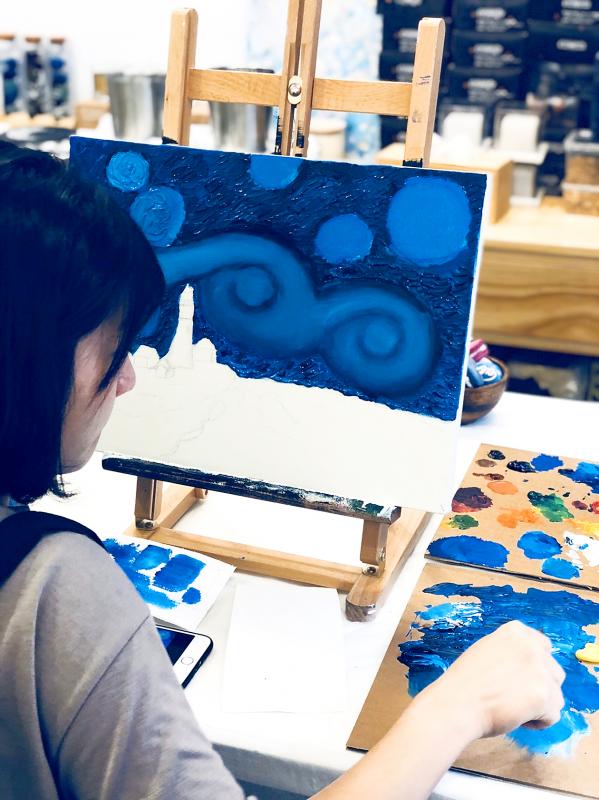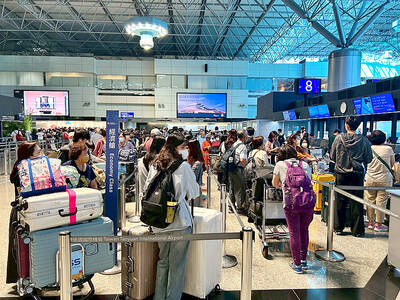Oil painters could be at risk of lead poisoning due to long-term exposure to chemicals often found in oil paints and and other paint media, a doctor said on Thursday.
Taipei’s Lianching Clinic assistant director Frankie Gan (顏佐樺) said that he found excessive levels of lead in the blood of a 59-year-old artist surnamed Wu (吳) after she visited the clinic for chronic stomach pain and headaches.
Long-term lead exposure significantly affects many of the internal organs and could cause stomach pain, loss of appetite, constipation, headaches, anemia, restlessness, numbness in the hands and feet, mental impairment and memory loss, and in more extreme cases could even result in chronic high blood pressure, cardiovascular disease, kidney damage and infertility, Gan said.

Photo courtesy of Lianan Wellness Center
The physician said that most of the people he has encountered with excessive internal lead levels had regular contact with toxic materials at work, for example in automobile manufacturing, welding and painting.
Consuming produce from a farm with polluted soil or taking traditional Chinese medicine with a high lead content could also increase blood lead levels, Gan said, reminding the public to only buy medicine from certified doctors and approved pharmacies.
As the body cannot easily expel toxic metals, they accumulate in fat and bone, affecting the heart, lungs, kidneys, liver and nervous system, potentially leading to gastrointestinal, immune and cognitive dysfunction, Gan said.
Exposure to heavy metals such as lead, mercury, arsenic, aluminum and cadmium is no longer rare, but as heavy metal poisoning does not have specific symptoms, most people do not suspect it to be the cause of their condition and do not get immediate treatment, he added.
If a person cannot ascertain the cause of certain symptoms and is regularly exposed to toxic materials in their workplace or living environment, Gan recommends taking a nutrient and toxic element blood test to determine if excessive metal levels are present.
Gan also urged the public to eat more wood-ear and snow fungus, kelp, spirulina, cilantro and other foods high in dietary fiber and vitamin C, as this helps the body eliminate toxins.
Commenting on the case, National Taiwan Normal University Department of Fine Arts professor Huang Chin-lung (黃進龍) on Thursday said that painters must remain mindful of paint quality, technique, studio ventilation and their habits.
Many oil painting techniques require mixing pigment with media that might include white lead, zinc oxide or titanium dioxide, Huang said, advising painters to avoid purchasing cheap, low-quality materials.
Painters who spray pigment are at heightened risk, Huang said, adding that for those painters, studio ventilation is of utmost importance.
Artists’ habits are also crucial, Huang said, adding that testing colors on one’s fingernails, not washing one’s hands after painting and eating while painting could hasten metal poisoning.
Some oil painters are more than 90 years old, which shows that the materials themselves are not dangerous, but it is a painter’s habits that matter most, he said.
As oil painting can be dangerous, some artists prefer to use acrylic paint or watercolors, but oil still has an aesthetic quality that is irreplaceable, Huang added.
Additional reporting by Wu Po-hsuan

Three batches of banana sauce imported from the Philippines were intercepted at the border after they were found to contain the banned industrial dye Orange G, the Food and Drug Administration (FDA) said yesterday. From today through Sept. 2 next year, all seasoning sauces from the Philippines are to be subject to the FDA’s strictest border inspection, meaning 100 percent testing for illegal dyes before entry is allowed, it said in a statement. Orange G is an industrial coloring agent that is not permitted for food use in Taiwan or internationally, said Cheng Wei-chih (鄭維智), head of the FDA’s Northern Center for

The Chinese military has built landing bridge ships designed to expand its amphibious options for a potential assault on Taiwan, but their combat effectiveness is limited due to their high vulnerability, a defense expert said in an analysis published on Monday. Shen Ming-shih (沈明室), a research fellow at the Institute for National Defense and Security Research, said that the deployment of such vessels as part of the Chinese People’s Liberation Army (PLA) Navy’s East Sea Fleet signals a strong focus on Taiwan. However, the ships are highly vulnerable to precision strikes, which means they could be destroyed before they achieve their intended

About 4.2 million tourist arrivals were recorded in the first half of this year, a 10 percent increase from the same period last year, the Tourism Administration said yesterday. The growth continues to be consistent, with the fourth quarter of this year expected to be the peak in Taiwan, the agency said, adding that it plans to promote Taiwan overseas via partnerships and major events. From January to June, 9.14 million international departures were recorded from Taiwan, an 11 percent increase from the same period last year, with 3.3 million headed for Japan, 1.52 million for China and 832,962 to South Korea,

REWRITING HISTORY: China has been advocating a ‘correct’ interpretation of the victory over Japan that brings the CCP’s contributions to the forefront, an expert said An elderly Chinese war veteran’s shin still bears the mark of a bullet wound he sustained when fighting the Japanese as a teenager, a year before the end of World War II. Eighty years on, Li Jinshui’s scar remains as testimony to the bravery of Chinese troops in a conflict that killed millions of their people. However, the story behind China’s overthrow of the brutal Japanese occupation is deeply contested. Historians broadly agree that credit for victory lies primarily with the Chinese Nationalist Party (KMT)-led Republic of China (ROC) Army. Its leader, Chiang Kai-shek (蔣介石), fled to Taiwan in 1949 after losing a